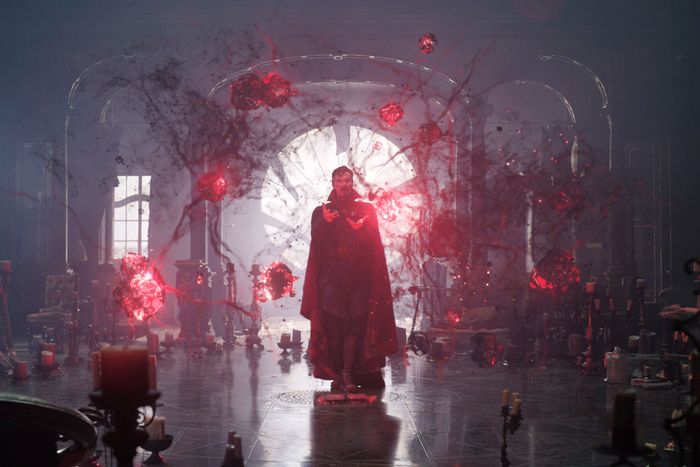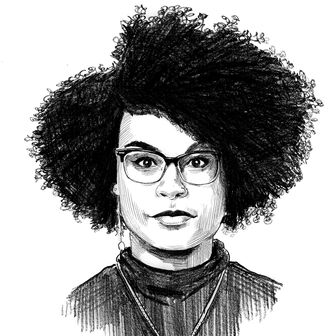
The pleasure of director Sam Raimi’s trilogy of Spider-Man films beginning in 2002 can be found in the bombast. Its arch dialogue and visual ecstasy serve to streamline our understanding of the characters, allowing them, as well as the world they inhabit, to feel uniquely real even with its heightened tone. The swooning camerawork elevates sequences like the failed surgery of Doc Ock (Alfred Molina) in Spider-Man 2 — darkness swallows the characters whole, while the cutting sound design of nails scraping against tile leaves you with goosebumps. The body can be a site of horror and power in the superhero genre, an idea that is made lightning bright by a combination of good scripting and the approach actors take to it. But in films as mammoth as these, the latter can only go so far.
In hiring a beloved “auteur” like Raimi to take over the Doctor Strange sequel, Marvel has given the Multiverse of Madness some heft. It has also piqued audience expectations for a familiar blend of pop art and macabre intrigue. These are expectations that aren’t quite met in the latest MCU installment, a truth not so much surprising as it is grimly disappointing. Your career either dies with some integrity or you live long enough for your artistry to be absorbed and nullified by the Marvel machine. And it’s easy to see why Marvel would absorb Raimi, with all his weight and prestige, into its machinery. Doctor Strange in the Multiverse of Madness is trying for a blend of horror and humor, something close to the heart and terror that Raimi was able to bring to bear throughout his career. But here, his craft has been hemmed in, gamified, leeched of color and vivacity. The plot, as it stands, is held together with bubblegum and a prayer. Doctor Stephen Strange (played with a foot out the door by Benedict Cumberbatch) performs daring feats of sorcery and jumps through a variety of poorly crafted universes with America Chavez (Xochitl Gomez), an interdimensional being who can punch holes through universes (if only she could learn how to wield such abilities), in hopes of outmaneuvering the incredibly powerful, and now completely batshit evil, Wanda Maximoff–slash–Scarlet Witch (Elizabeth Olson).
There are moments with intriguing Raimi ideas behind them — when a tentacled beast’s eye is plucked out; when Doctor Strange possesses a corpse in another universe; when a mystical battle involves notes of music alight in the air; when a whole universe turns into a graying graveyard with only a single spark of life. Bodies here and there are left mangled and bloody, and alternate versions of characters we’ve come to know appear throughout. Multiverses have an intrinsically somber quality as they are evidence of the road not taken and the people who we could have been if things were different. But Doctor Strange’s multiverse is neither emotionally resonant nor artistically agile enough to leave an impression. There’s a sequence in which America and Doctor Strange find themselves traveling through universes at a breakneck speed, each more debilitating than the last. One is underwater. Another transforms them into cartoon characters. In another, they’re garish, living paint. The ideas that hold a gleam of potential are shot down by the film’s rank ugliness, its incessant pace of exposition, the utter slog of the first hour, and the insistence on special effects that render the horrifying as textureless.
I come to Marvel films hoping for something to hold onto, for a wisp of the electric thrill audiences around me feel. Instead, Doctor Strange in the Multiverse of Madness left me more disenchanted than ever. How can I not raise my eyebrow at the casting of America Chavez, who has predominantly read as Afro-Latina in comics? How can I not notice that the Zombie Doctor Strange has less frisson than Billy Butcherson’s mangled corpse in Hocus Pocus? Doctor Strange 2 is too keenly aware fans don’t need much to cheer at these wretched undertakings. These are corporate installments for shareholders rather than, you know, actual films. This is perhaps how we arrive at screenwriter Michael Waldron’s utterly sexist conception of Wanda.
Since the events of WandaVision (which you would need to watch to get what the hell is going on here), the Scarlet Witch has leaned full tilt into her now-villainous persona, eyeing America’s powers as a way to reach a universe where her fake children are actually alive. In this universe, dreams are windows into the lives of our multiversal selves, and for Wanda, her dream involves being a suburban housewife. Without Vision, or any inkling of Wanda’s desires beyond her children, this dream comes across as even more claustrophobic. Apparently Wanda — an immensely powerful witch who can bend reality — only aspires to be a mom. It’s her single, devouring need, and when it’s not met, she loses her mind, leading to death and destruction for everyone around her. Waldron’s story juxtaposes the composed Doctor Strange and Wanda to make evident her inability to control her emotions and her powers. (The characterization harkens back to the discomforting nature of Black Widow, who in Age of Ultron was revealed to have been sterilized.) Marvel is cunning in how it projects the appearance of meaningful representation in its stories, whether it be the totemic royalty of Black Panther or the glimmer of queer folks in Eternals. If they’re doing white women so dirty, how can the rest of us expect any better?
Olson is saddled with a character so thinly written as a crazy bitch, who can neither control her emotions nor her great powers, that of course her performance is half-hearted and tepid. Cumberbatch is on autopilot beside her. Gomez is given only quips and exposition scenes, turning a character that is meant to be spunky aggressively bland. (I won’t even get into the Illuminati, a group of superheroes in another dimension that is so clearly meant to satisfy internet fancasting.) The film strives to be blatantly weirder, bloodier, and more gruesome than the usual MCU fare (which is really not saying much as this series is primed to appeal to the widest audience possible), but it remains so disconnected from the tactile experience of inhabiting a living body that the effort feels pallid. If you squint your eyes, you can see the Raimi sheen, but every broadly odd moment is ultimately devoid of the brio and complication necessary. After all, grotesquery isn’t solely about the images but what message they’re communicating. The message here: All this murder and insanity is the result of one woman and her desperate need to have (imaginary) kids.
Discussing Marvel films, and now TV shows, has come to feel like commenting on business decisions rather than artistic ones. The superhero juggernaut shows no signs of slowing down as it balloons in ways that force audiences to subscribe to Disney+ to understand the full litany of connections across its characters and worlds. It’s information gluttony. Yet audiences have been trained to subsist on scraps of diversity, of joy, of appropriately attuned bombast. There isn’t much else to say about these films. Doctor Strange in the Multiverse of Madness feels like a bridge to further stories rather than a work that stands on its own. How can it when there’s no end on the other side of the bridge in sight?
More Movie Reviews
- An Exploited Neighborhood, Seen Through Children’s Eyes
- Challengers Is Almost a Sexy Movie
- Zack Snyder’s Screensaver Space Opera Comes to an Uneventful End





